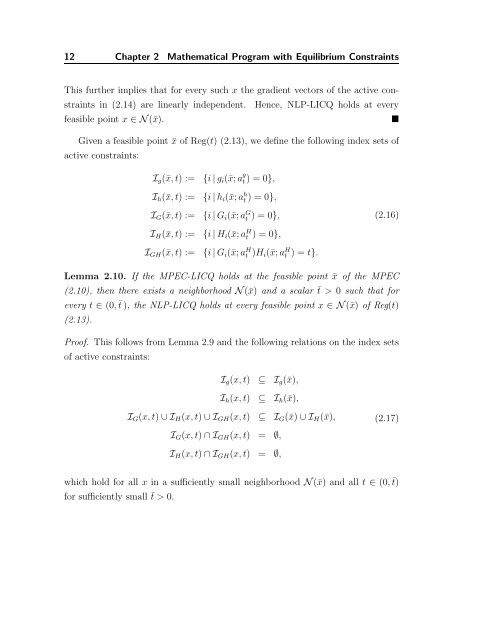equilibrium problems with equilibrium constraints - Convex ...
equilibrium problems with equilibrium constraints - Convex ...
equilibrium problems with equilibrium constraints - Convex ...
Create successful ePaper yourself
Turn your PDF publications into a flip-book with our unique Google optimized e-Paper software.
12 Chapter 2 Mathematical Program <strong>with</strong> Equilibrium Constraints<br />
This further implies that for every such x the gradient vectors of the active <strong>constraints</strong><br />
in (2.14) are linearly independent. Hence, NLP-LICQ holds at every<br />
feasible point x ∈ N(¯x).<br />
<br />
Given a feasible point ¯x of Reg(t) (2.13), we define the following index sets of<br />
active <strong>constraints</strong>:<br />
I g (¯x, t) := {i | g i (¯x; a g t) = 0},<br />
I h (¯x, t) := {i | h i (¯x; a h t ) = 0},<br />
I G (¯x, t) := {i | G i (¯x; a G t ) = 0},<br />
(2.16)<br />
I H (¯x, t) := {i | H i (¯x; a H t ) = 0},<br />
I GH (¯x, t) := {i | G i (¯x; a H t )H i (¯x; a H t ) = t}.<br />
Lemma 2.10. If the MPEC-LICQ holds at the feasible point ¯x of the MPEC<br />
(2.10), then there exists a neighborhood N(¯x) and a scalar ¯t > 0 such that for<br />
every t ∈ (0, ¯t ), the NLP-LICQ holds at every feasible point x ∈ N(¯x) of Reg(t)<br />
(2.13).<br />
Proof. This follows from Lemma 2.9 and the following relations on the index sets<br />
of active <strong>constraints</strong>:<br />
I g (x, t) ⊆<br />
I h (x, t) ⊆<br />
I g (¯x),<br />
I h (¯x),<br />
I G (x, t) ∪ I H (x, t) ∪ I GH (x, t) ⊆<br />
I G (x, t) ∩ I GH (x, t) = ∅,<br />
I G (¯x) ∪ I H (¯x),<br />
(2.17)<br />
I H (x, t) ∩ I GH (x, t) = ∅,<br />
which hold for all x in a sufficiently small neighborhood N(¯x) and all t ∈ (0, ¯t)<br />
for sufficiently small ¯t > 0.
















